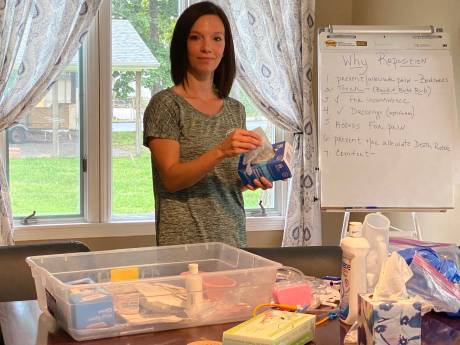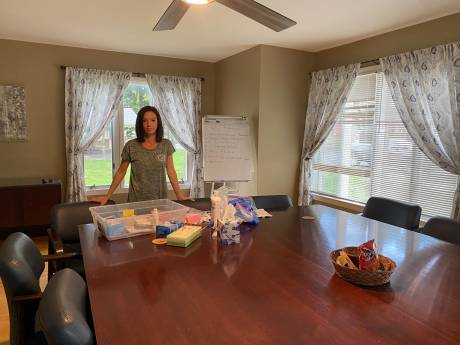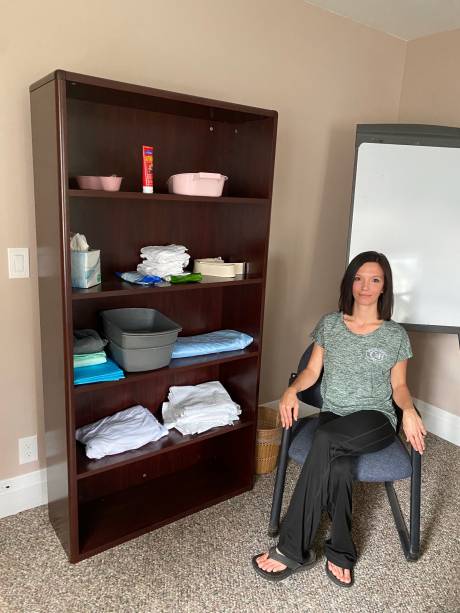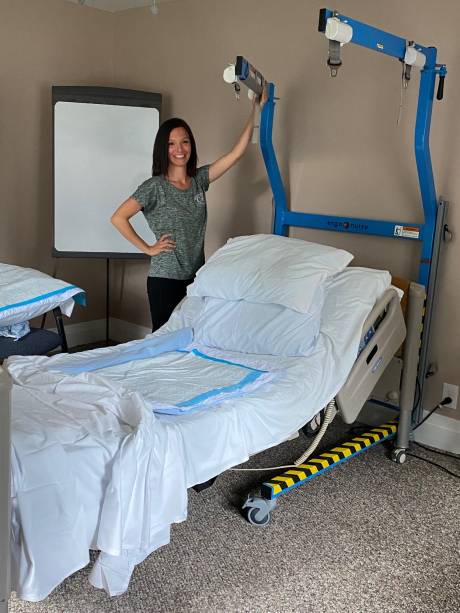
Editor's note: This is the third part of a series about the new staff at Crossroads House in Batavia, which will celebrate its 25th anniversary in January.
Out of all the physical, hands-on training hours that Ashley Manuel conducts for new volunteers, they aren’t usually the most difficult part of the job.
“It’s the emotional,” Manuel said at the Crossroads House training site on East Main Street, Batavia. “I think the physical becomes secondhand. Probably the number one question is, ‘how do I act?’ Sometimes there’s no right thing to say. Yea, the emotional is hard.”
As volunteer coordinator for the nonprofit comfort care home on Liberty Street, the 33-year-old knows how to run through the drills: rolling residents over as needed; properly using an Ergo Nurse to pull them up the bed toward their pillows; and how to use a bedpan, empty a catheter container and swab the mouth.
As for those emotional moments when talking with patients and their family members, feeling the knee-jerk response of tears welling up, and feeling sadness, those aren’t quite so easy to navigate, she said. After all, the people at Crossroads House are usually at the end of their lives. They are called residents, and they’re people with thoughts, feelings, questions, fears, and sometimes unresolved family issues. In other words, they’re human.
“You fall in love with these people,” Manuel of Batavia said. “You sympathize, but it’s hard to rewire … I think it’s our innate nature to want to feed and take care of someone.”
Manuel has been learning her way through the house, as a volunteer, overnight aide and, as of June, volunteer coordinator. She became familiar with Crossroads when her grandmother stayed there in 2016. She saw firsthand what a “good death” can be: filled with the smell of home cooking, the sounds of her four children running around and playing, and a sense of peace in the air.
“Death is inevitable; why not make it a good one?” she said. “It feels more like family (at Crossroads).”
She has been recruiting via social media, a Bring a Buddy program for current volunteers and giving talks during church coffee hours. Of all of those techniques, it often comes down to word of mouth, she said. People just like her who experienced the house firsthand often come back to volunteer. There's always a need for more, she said, and there are many tasks to do besides hands-on care of residents, such as housekeeping, office work, gardening, raking leaves and shoveling snow.
As a volunteer, she was giving of herself, though it didn’t quite feel that way.
“I think I have a caregiver’s heart. I feel I get more out of it than the resident does,” Manuel said. “It’s humbling that they’ll let you take care of them, it’s very sweet.”
People looking at their final days often fall into similar patterns, she said. They will stop eating solid foods, and shift to liquids, popsicles or ice cream — “We eat a lot of ice cream,” she said. “And it kind of dwindles down.”
It isn’t always the resident who becomes most distressed about that regression from life, but the family, she said. Those innate desires to feed and nourish a loved one can be really strong, and it may become more difficult to acknowledge the truth. That’s all part of the education about what happens when the loved one does begin to move away from life-affirming activities, she said.
Taught by Crossroads founder Kathy Panepento, Manuel feels as though she was taught to fish. She has become more confident in her own abilities through Panepento’s experienced advice and now carries that onward to help others, Manuel said.
During family meetings, volunteers emphasize not to push anything on a resident, and that it’s OK to let the process happen. At that point, family members often display a visible sign of recognition, she said.
“That’s when you start to see the demeanor of the family change,” Manuel said. “They’re like ‘wow, this is real … this is happening.’”
She believes that pushing food on someone who is dying is an unnecessary weight, literally and figuratively.
“Food weighs us down,” she said. “The soul is trying to leave the disease.”
Part of the family educational piece is to encourage members to talk — about the good times and the bad times, she said. There are no rules, and there may be issues to deal with, talk about, and ideally resolve. It’s a vastly different atmosphere than a sterile hospital with doctors, IV tubes and machines, and Manuel encourages visitors to act normally, laugh, joke, cry, and get in bed alongside a loved one if prompted to do so. This is an opportunity for families to heal.
“Every family has their (stuff), get it off your chest,” she said.

All of what Manuel has soaked up will be wrung out for new volunteers to absorb. She feels fortunate to have the training house rental (a former rectory of St. James Episcopal Church) to conduct group and one-on-one training for all of the needs likely to come up at the actual site. She shows a movie about dying, discusses the origins of Crossroads and makes everyone do what they’re asked to do for residents — sit on a bedpan, run a swab around their mouths, use an oximeter, a gait belt, a denture kit, medicated bandages, Ergo Nurse and be rolled over in bed.

Those lessons definitely involve how to physically perform each exercise, however, Manuel also wants them to grasp the importance of being gentle and maintaining each resident’s dignity throughout the course of his or her stay. And of course, there’s the emotional part.
“I always have the tissues out when we watch the movie,” she said. “We love our volunteers, they do so much. Someone asked me ‘are we allowed to cry?’ Yes. I’ve sat and cried with many families."

Crossroads House Volunteer Coordinator Ashley Manuel shows some of the items that volunteers learn to use during training at the training home on East Main Street; the home is fully equipped with training materials, supplies, equipment and a bed for ample practice. Photos by Joanne Beck.
